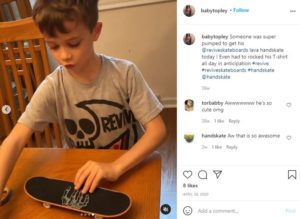Without influencers, HandSkate.com would have been dead in the water, says Bryan Tracey, founder of the brand.
Since 2014, Tracey has owned and operated SkateXS, a web-only merchant that sells smaller-sized skateboards geared toward children. In 2017, his son—then 14 years old—discovered a hand skateboard toy from a video of someone playing with it on the internet. A handskate, or handboard toy, is an 11-inch skateboard that consumers can operate with their hands to emulate skateboard tricks, such as doing tray flips and jumps.
The company that used to manufacture this product stopped, and the only way to buy hand skateboards was by coming across them as a collector’s item on marketplaces like eBay for around $80, Tracey says.
Even though the manufacturer stopped producing the product, Tracey saw the joy his son got from playing with one. He made the bet that if more people knew about the product and it was sold at an accessible price point, he could create a market for it—and a business. Because he operated SkateXS.com and already manufactured skateboards in China, he had the right contacts to set up manufacturing quickly.
But before taking the plunge into a new business with a new product, Tracey knew he would need influencers on his side.
“Here was a completely unknown product; nobody had heard of handskates. It’s a new concept. People are not Googling for it,” Tracey says. “You need to get it in front of eyeballs, and you don’t own those eyeballs, you don’t have direct access.”
Building influencer relationships
Tracey took the plunge and manufactured 1,000 units. He identified a handful of people with followings on the internet—influencers who had previously posted videos with a handskate—and sent the toy prototypes to them. Tracey was confident these few influencers would be excited about the product, believe it was a good fit for their audience and would be happy to create a video about the product and essentially promote it for free.
The bulk of the influencers Tracey identified worked at skateboarding company Revive, which is both a skateboarding team and brand of skateboards. The group started as skateboarders posting their tricks on YouTube and eventually, they started their own ecommerce site, TheShredQuarters.com, to sell their own skateboards. These influencers were ideal recipients of the hand skateboards because they already had an engaged social media following and a few of these skating team members had previously posted videos with toy hand skates.
Tracey sent the company a case of 20 handskates along with a letter introducing him and his company. From previous videos, Tracey also knew one of the influencers was a Star Wars fan. So, Tracey and his son drew pictures of Star Wars Jedi characters on the box with the phrase “These are the handskates you’ve been waiting for.”
“We wanted to make sure they opened the damn box,” Tracey says. Luckily, they did, and two members from the skateboarding team posted videos.
The letter, Tracey says, made it clear that it was a no-strings-attached gift. “We weren’t sure how they would handle it, and they handled it in the best possible way,” Tracey says. “The main video all started with the product in the box, they introduced the company and said, ‘Somebody is finally making these.’”
The video continued with the influencer opening the product and demonstrating it for several minutes, then told viewers where they could buy it and included a link to the handskate website in the description.
“I think it was exactly the best case. If we had thought to ask for something, that was what we would have asked for,” Tracey says.
Backed by known people in the brand’s target market, the product had legitimacy and was set for growth. Within a few hours of the influencer’s video going online, 100 orders came in.
In fact, that initial shipment turned into a wholesale relationship. Now, HandSkate manufacturers handboards with the Revive branding on it, which Revive sells on its website.
The brand has had steady growth, with sales growing 50% year over year in the first few years, Tracey says. In 2019, HandSkate neared 10,000 units in annual sales, and its goal for 2021 is to surpass that. Because of the pandemic, HandSkate had manufacturing issues in 2020 and did not sell products for most of the year.
Turning HandSkate customers into influencers
From its initial bump from the handful of videos from influencers, now—more than three years later—HandSkate.com is still riding the wave of the long tail.
“The long tail graphs all start with that big peak on the left—that’s the one person who has that huge influence over a lot of people,” Tracy says. “The long tail is the many, many, many people who have a much smaller circle of influence, and that becomes our customer base. That became the people who had these handskates because they happened to follow one of the primary influencers. But that doesn’t mean their friends follow the primary influencers.”
Now, those customers are playing with these toys and the word of mouth is growing. HandSkate’s job now is to nurture that growth and turn these customers into its next base of influencers.
Tyler’s son is in charge of the social media accounts, with the goal of making sure the company likes or comments on every post he can find that includes the HandSkate product.

Merchant HandSkate.com works to comment on each social media post it is tagged in.
“We publicly comment on their post. We are saying, ‘good job, way to go.’ Go share and promote those videos, even if it’s not a big deal, even if it wasn’t the best video, even if they are not doing the most amazing trick, even if they don’t have hundreds or thousands of followers, that doesn’t matter,” Tracey says.
“Their circle of influence is their friends, and if you can do something to say thank you, to acknowledge them, to encourage, to support, that sort of thing goes such a long away for them to put the next video out and the next photo out,” he adds.
Consumers who purchase the product and post about it to their friends provide a much larger conversion, even if they have just 20 followers, than an influencer with thousands of followers paid to promote it, he says.

HandSkate.com hopes that commenting on social media posts with its products will encourage its customers to continue posting and talking about its products.
For this reason, Tracey declines to work with influencers who reach out to the brand who are not its end customers, such as a mom who wants to promote the product as a Christmas gift on her blog, he says.
HandSkate creates branded products for the Revive skateboarding team, and the team publishes videos featuring HandSkate’s product, but there is no formal contract. The initial influencers that provided the brand’s foundation still post videos with the HandSkate product, but that type of exposure is no longer the brand’s focus.
“We’re trying to celebrate the success of our normal customers who are just willing to go out in the world and post what they learned to do yesterday,” Tracey says.
This strategy is working, as Tracey estimates that 80-90% of its sales are from word of mouth on social media. The brand does not spend any marketing dollars on paid social content, nor does it spend many marketing dollars in general. Occasionally, it will run keyword campaigns on Amazon to ensure consumers can find its product on the marketplace. More than half of the brand’s sales are from Amazon, he says.
Favorite